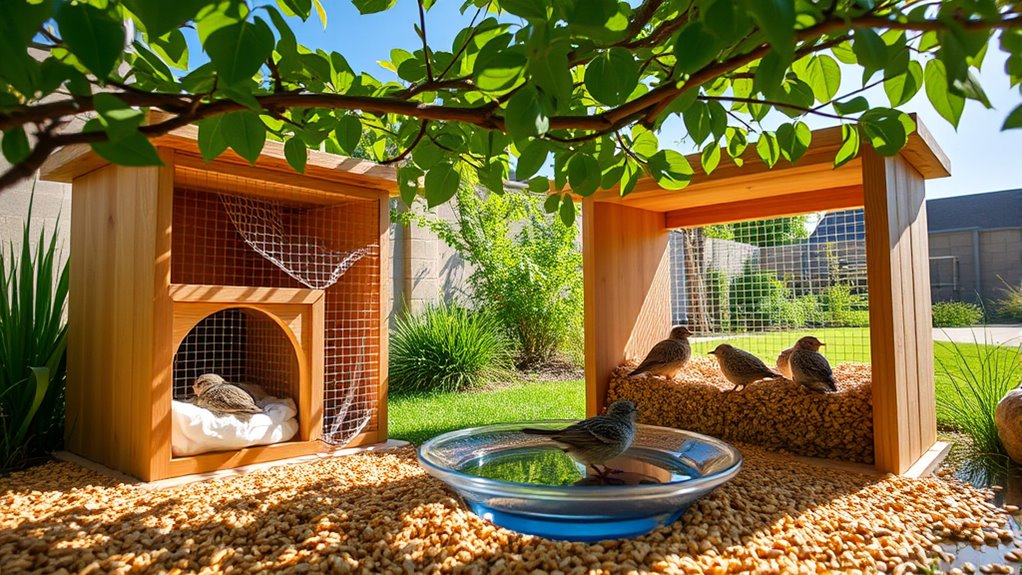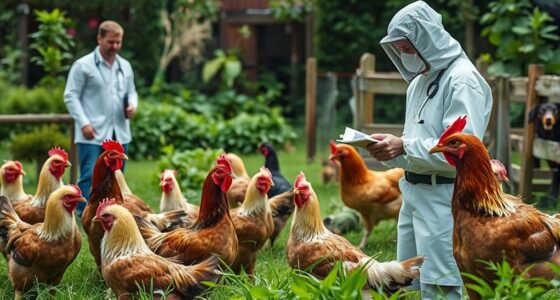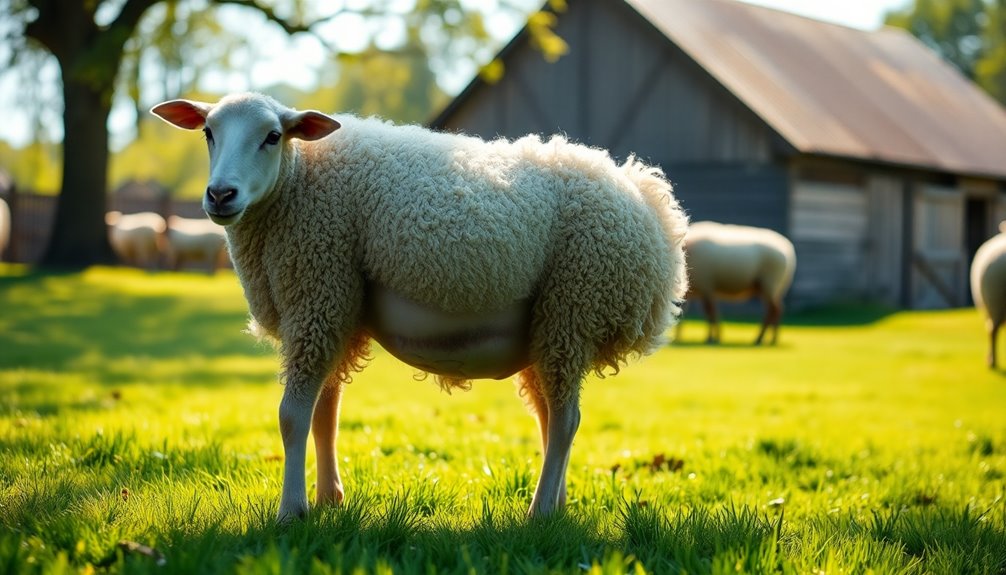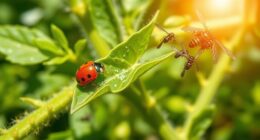To build a habitat for quail, start by ensuring you have enough space—one square foot per bird is essential, but three is better. Choose an appropriate enclosure like a rabbit hutch or aviary, and incorporate essential features like nesting cover and bare ground. Provide high-protein feeds and fresh water for proper nutrition. Lastly, consider environmental factors, ensuring shelter and protection from predators. Keep going to discover more tips for a thriving quail habitat!
Key Takeaways
- Provide a secure enclosure with 1-3 square feet per quail to prevent flying and protect against predators.
- Choose suitable housing such as rabbit hutches, aviaries, or DIY designs using hardware cloth for safety.
- Incorporate nesting cover using native grasses, dead vegetation, and brushy areas for escape and comfort.
- Ensure a balanced diet with high protein feeds, calcium for layers, and fresh water available at all times.
- Maintain diverse vegetation structures and avoid habitat fragmentation for optimal quail health and mobility.
Space Requirements for Quail
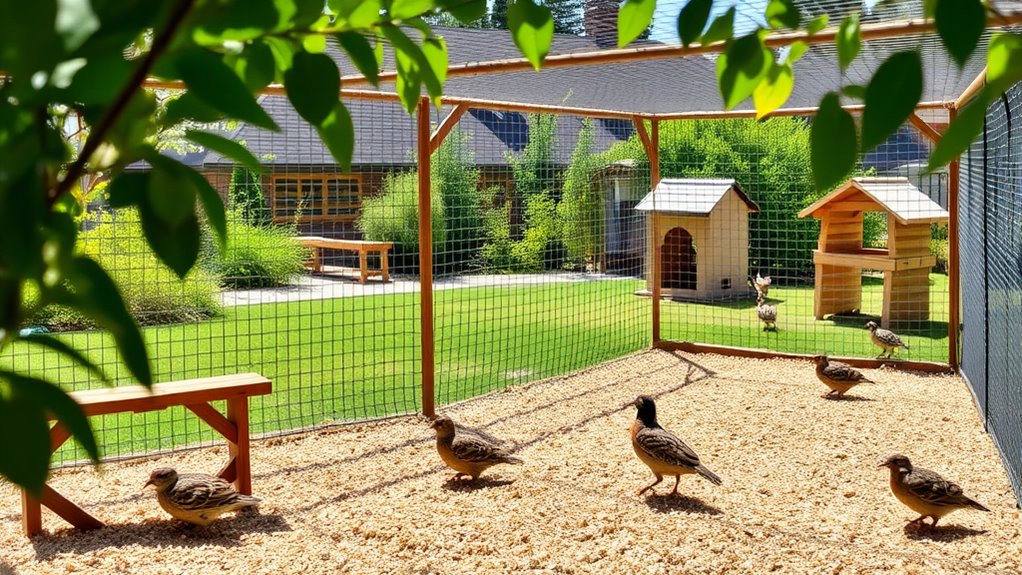
When it comes to space requirements for quail, you'll find that they need relatively minimal room compared to larger birds. Ideally, you should provide about 1 square foot per bird, but 3 square feet is even better for their movement and comfort.
Since quail aren't suited for free-ranging due to their flight tendencies, it's crucial to design enclosures that prevent them from flying out and keep predators at bay. You can consider using mobile pens or quail tractors, which offer flexibility in managing their space.
Choosing the Right Enclosure
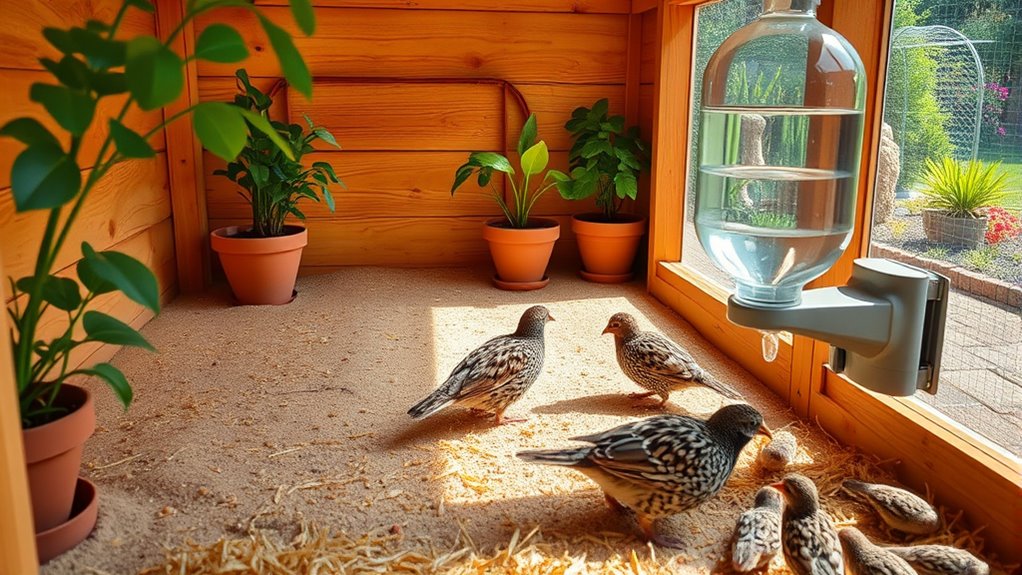
Finding the right enclosure for your quail is key to their comfort and safety. You have several options to consider.
Rabbit hutches are affordable and suitable for small groups, while aviaries provide a more natural environment, perfect for active breeds like New World quail.
Metal and plastic quail cages serve well for breeding, with plastic offering easier cleaning and rust resistance.
DIY hutches allow customization to fit your needs.
Ensure your enclosure uses hardware cloth for predator protection and includes secure doors.
Look for features that make cleaning easy, like sliding pans and grid flooring.
Always consider your available space and accessibility when choosing the right enclosure for your feathered friends.
Essential Habitat Features
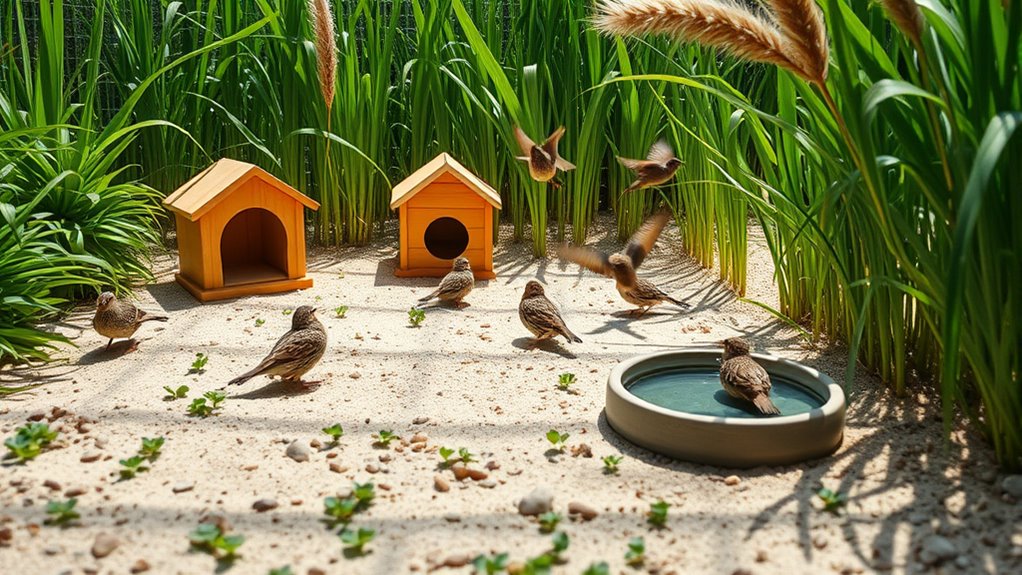
Creating an ideal habitat for your quail involves understanding their essential needs. Start with nesting cover, using native grasses like broomsedge and little bluestem, ensuring they're at least a foot tall for overhead protection.
To create a perfect habitat for quail, prioritize nesting cover with native grasses for essential overhead protection.
Incorporate 2- to 3-year-old dead vegetation for nest building and maintain bare ground for easy chick movement.
For brood-rearing areas, plant weedy species like ragweed and native wildflowers to attract insects.
Include brushy, shrubby land for escape cover, creating at least a 10-foot radius for protection.
Provide sparse vegetation of 1 to 3 feet for roosting, with open canopies for quick escape.
Lastly, focus on diverse vegetation structures and edges, ensuring quail have access to essential resources.
Nutrition and Hydration Needs
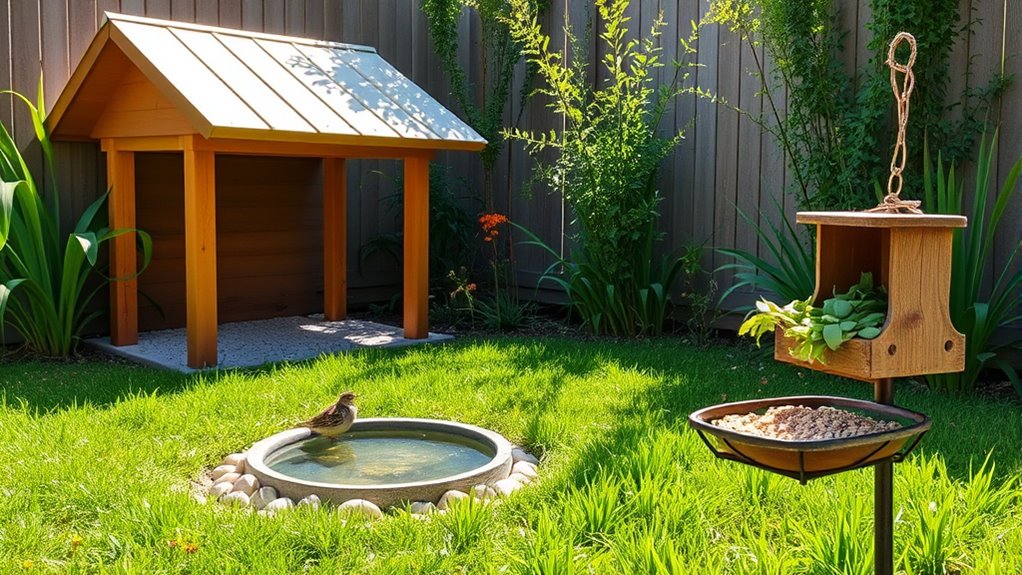
Understanding quail nutrition and hydration is essential for their health and productivity. Quails require high protein, especially during growth and egg production, so choose starter feeds with 24-30% protein.
As they grow, switch to grower feeds with 20-22% protein, and for adults, 18-20% is ideal. Supplement their diet with calcium to ensure strong eggshells, particularly for laying quails.
Fresh water should always be available; refill containers at least twice a day to prevent dehydration. Consider using automatic watering systems for consistency.
You can enhance their diet with greens, mealworms, and probiotics for better overall health. Keeping their nutrition and hydration needs in check will lead to a thriving quail population.
Environmental Considerations for Quail
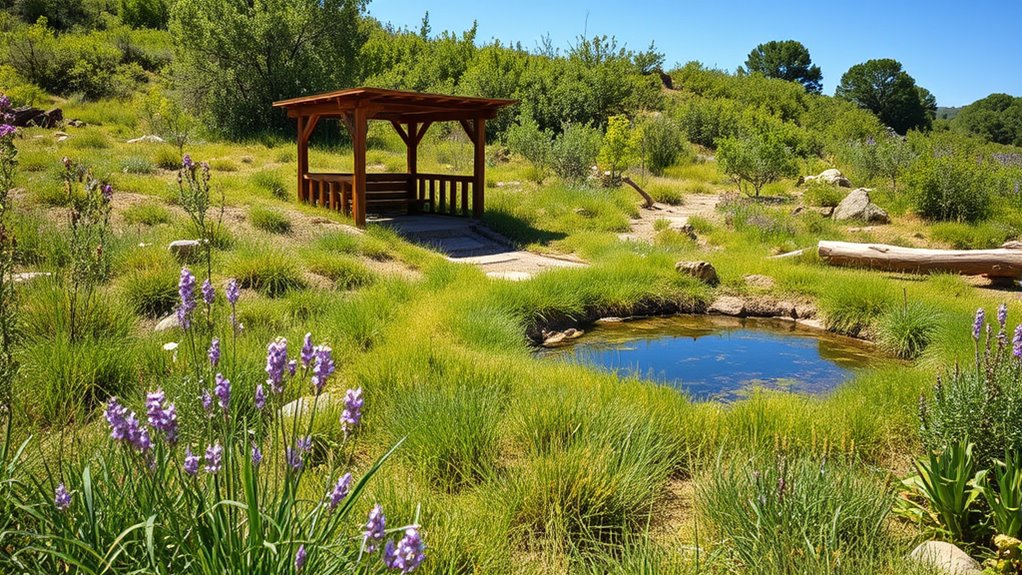
When planning a quail habitat, it's crucial to consider various environmental factors that directly influence their well-being.
Start by incorporating herbaceous plants and low-growing woody cover, as these provide essential shelter and food. Ensure there's bare ground between plants to aid quail mobility and chick development.
Incorporate herbaceous plants and low-growing cover for essential shelter and food, while ensuring bare ground for quail mobility.
Avoid habitat fragmentation; contiguous spaces are vital for quail populations. Use management techniques like prescribed burning and grazing to maintain optimal conditions.
Divide larger fields into smaller patches to enhance diversity, and improve edge habitats for nesting sites. Incorporate native plants to support the herbaceous community, and create brush piles near food sources for additional cover.
Pay attention to climate factors, ensuring shade and wind protection for your quail. Additionally, consider the importance of water sources as quail need accessible water for hydration and overall health.
Strategies for Predator Protection
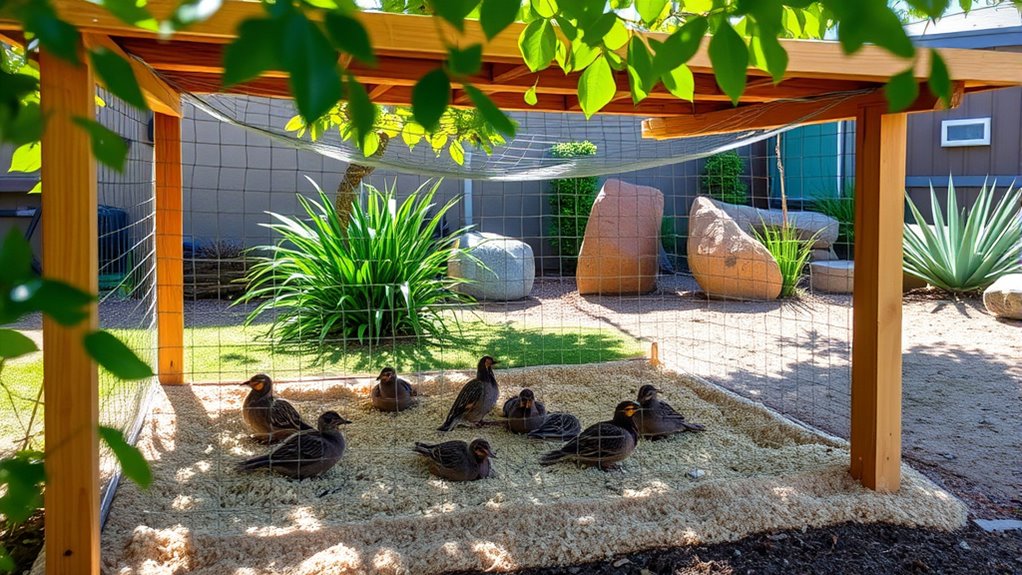
Maintaining a healthy quail habitat not only supports their survival but also plays a key role in protecting them from predators.
Start by ensuring quality habitat with tall bushes and shrubs for cover. Incorporate various cover types like brush piles and plum thickets, which help quail escape threats.
Increase plant diversity to attract alternative prey species, buffering against predation. Limit grazing to maintain cover and consider controlled burns to promote suitable plant growth.
Use game cameras and scent stations to monitor predator populations, allowing you to make informed management decisions.
Lastly, implement non-lethal controls like mechanical deterrents and year-round feeding to distract predators, keeping your quail safe and thriving in their environment. Additionally, ensuring diverse plant species can create a more resilient ecosystem that supports both quail and beneficial insects, further enhancing habitat health.
Raising Quail Chicks Successfully

Successfully raising quail chicks requires careful attention to their needs from incubation through to their early days.
Start by preparing the eggs: let them rest for 24 hours after shipping. Set your incubator to 95°F-105°F with 45-55% humidity, and turn the eggs regularly. After 17-18 days, they'll start hatching.
Prepare your quail eggs by resting them for 24 hours, then incubate at 95°F-105°F with proper humidity for hatching success.
Once hatched, transfer them to a draft-free brooder with a temperature of 95°F, decreasing by 5°F weekly. Feed them a high-protein crumble feed and ensure constant access to clean water.
Maintain cleanliness to prevent diseases and inspect for parasites regularly. To support their growth, provide social interaction and environmental enrichment like hiding spots.
With proper care, your quail will thrive!
Frequently Asked Questions
How Many Quail Can I Keep in My Backyard?
You can keep about 1 quail per square foot of space, but giving them more—around 3 square feet each—improves their well-being.
So, if you have a 10 square foot area, you could comfortably house 3-10 quails.
Just make sure your enclosure is secure and well-ventilated.
Also, consider local regulations, as they might limit how many birds you can keep in your backyard.
Can Quail Be Raised Indoors or in a Garage?
Imagine a cozy haven for your quail, reminiscent of a warm nest. Yes, you can raise quail indoors or in a garage.
These environments offer protection from harsh weather and predators. Just ensure you've got proper ventilation, adequate space, and enough light for egg production.
With some thoughtful setup, you'll enjoy the gentle sounds of quail while keeping them safe and comfortable year-round.
What Are Common Health Issues in Quail?
Common health issues in quail include bacterial infections like ulcerative enteritis and fowl cholera, which can lead to severe consequences.
Parasitic problems, such as worms and mites, can cause discomfort and hinder growth.
Viral diseases like quail bronchitis can be highly contagious, while protozoal infections like coccidiosis damage their intestines.
To keep your quail healthy, monitor them closely and address any signs of illness promptly.
How Do I Handle and Socialize With Quail?
To handle and socialize with quail, start by spending time near their enclosure, allowing them to get used to your presence.
Use gentle movements when approaching, and offer treats to build trust.
Make sure to handle them calmly, supporting their bodies securely.
Socialize them in groups to establish a pecking order and reduce stress.
Provide hiding spots and enrichment to encourage natural behaviors, which helps them feel safe and comfortable around you.
Are Quail Good Pets for Children?
Yes, quail can be great pets for children! Their gentle temperament makes them easy to handle, especially when they're accustomed to it from a young age.
They require minimal space, making them ideal for families with limited backyards. Quail are quieter than chickens, reducing noise issues.
Plus, caring for them teaches kids responsibility and offers fun educational opportunities, like collecting eggs and observing their habits.
Conclusion
Creating the perfect quail habitat is both rewarding and crucial for raising healthy birds. By considering their space, enclosure, and nutrition needs, you're setting the stage for success. Don't forget to protect them from predators and provide a comfortable environment. After all, isn't it amazing how a few thoughtful adjustments can lead to thriving quail? With your commitment and care, you'll enjoy the process and the delightful rewards of raising these charming birds.

